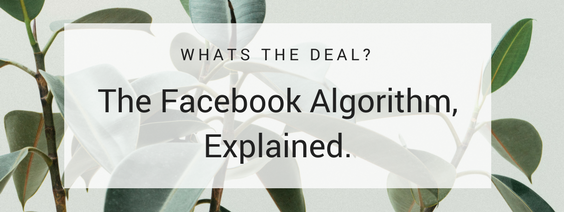What You Need to Know About the Facebook Algorithm in 2018
The Facebook algorithm has continued to morph, confusing brands/publishers as to A) how it works and B) how they can benefit the most from it.
This blog post aims to inform and educate you on the current state of the Facebook algorithm and how you can extend the life of your posts in the news feed.
You may have seen our previous blog post about the changes to the Facebook newsfeed. Mark Zuckerberg announced the changes a few short weeks ago, but the truth is, the newsfeed shift has been happening for quite some time.
Facebook has a huge incentive for making this shift. In recent years, the platform has received a lot of scrutiny for fake news and increasing feelings of inferiority and even depression.
The social media giant will be prioritizing personal and meaningful posts for its users, limiting post and ad impressions from brands. This means, you're more apt to see photos of family vacations, pictures of food, and motivation quotes than you are from the brands you love most.
But before we dive to deep, let's understand Facebook's core values we can clearly distinguish the types of content Facebook wants. In order of importance, here is what the social behemoth craves from us on a daily basis.
1. Personal Content: meaning, photos and videos of your friends and family.
2. Ideas: Facebook is passionate about diversity. They want our collective ideas, and strives to give everyone a platform to share those ideas safely.
3. Authenticity: Facebook wants content that is real & authentic versus spammy and self-promoting.
4. User Experience: Facebook aims for a completely customized platform for each user. Functions like follow/unfollow or "see first" make the user experience one-to-one and personal to the individual.
Based on these values, the Facebook algorithm determines what content should be served, where, and to whom.
Here is an amazing explainer video from Adam Mosseri, the VP of Product Management for Facebook News Feed. We highly recommend taking 7 minutes to watch this video.
Essentially, it works like this.
1. The algorithm is extremely user-centric. Meaning, when you post something, nothing happens immediately. It's not until the people that follow you logon to Facebook, that the algorithm decides out of all the possibilities, which pieces of content should be served to that person first.
2. Each user builds their own customized experience. When you first sign up with Facebook, you have a blank slate. You then add friends, "like" publishers/brands, and so on. Thus, the Facebook algorithm does it's best to serve you content that is centered around the things you value most. The algorithm is all about user experience.
3. Based on each user, Facebook's job is to determine which content is most important. This is called a "Relevancy Score." It does this by looking at:
a) Who posted it. If it is a post from someone you regularly like and engage with, Facebook will likely mark the post as relevant to you.
b) What type of content. If you typically like more photos vs. videos, Facebook might send you more photo-based content and vice versa.
c) How many interactions are on the post. Out of multiple possibilities, Facebook may choose the post that has the most likes and comments, and serve that content to you first.
d) When it was posted. In many cases, recency=relevancy...But not always. The algorithm will still promote older content if it deems it more important to you. In the above video, Adam describes his sister being engaged. He was not on Facebook the week of the engagement announcement. However, a week later, when he logs in, Facebook is likely to put the engagement post at the top of his feed over other relevant content from his sister or other close friends and family.
---
We also know by listening to Facebook's ever changing demands, that they are prioritizing video content. Facebook has highly encouraged brands to utilize video to stay top of mind since the beginning of 2017. Those who do not jump on the bandwagon and adopt video content will be receiving much lower monthly impressions and reach figures, and likely higher CPR rates.
There are several things you can do to keep your small business top of mind on Facebook. The key thing to understand is that you need to be flexible and adaptable. This is just one of many major algorithm overhauls, so buckle up and get comfortable with dynamic social strategies.
Have questions about your social media marketing strategy? Don't be shy - we love questions.


